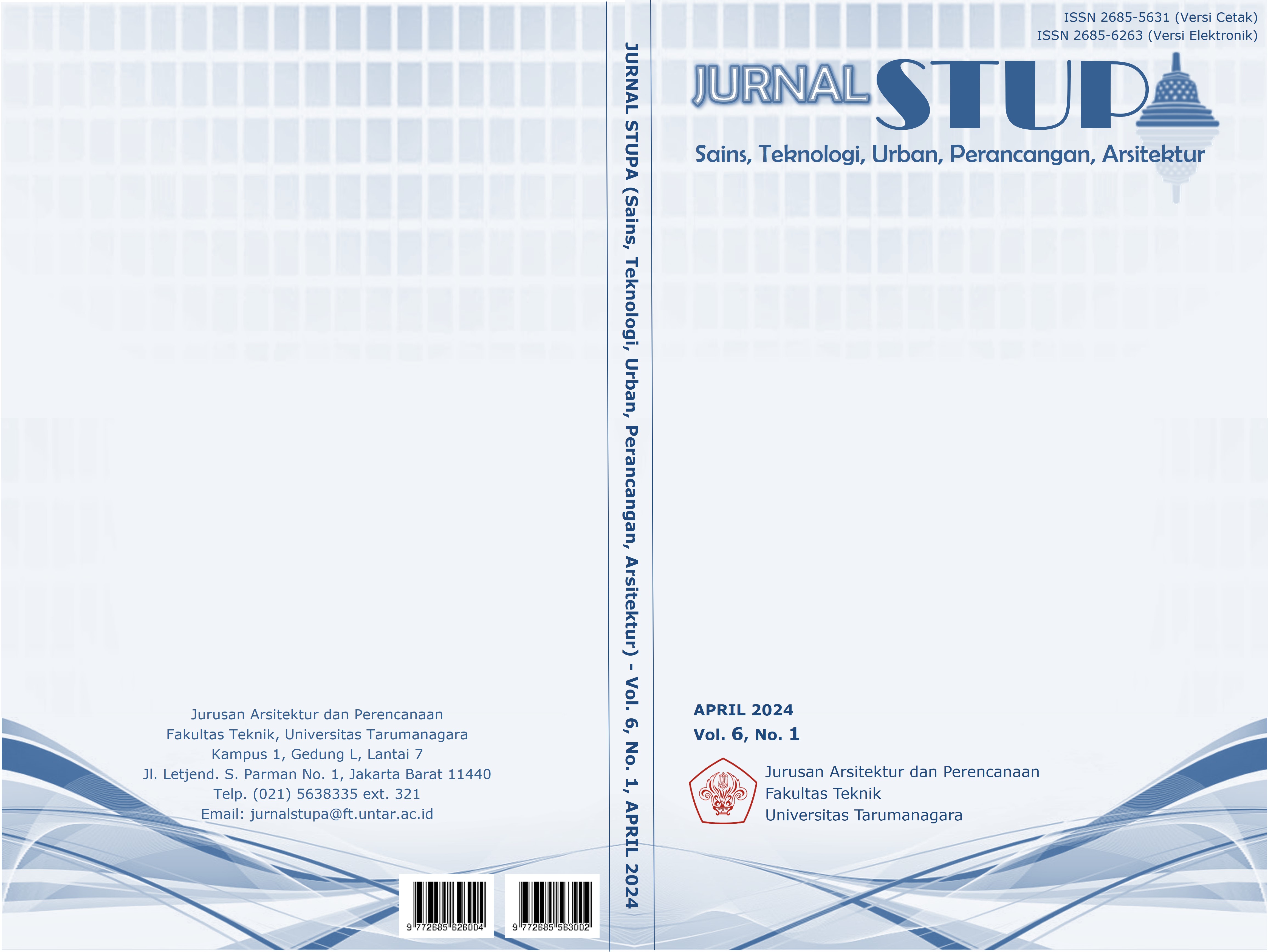KONSEP ERGONOMI BARU TERKAIT LANSIA SEBAGAI PRINSIP PERANCANGAN PADA SENIOR FARMERS MARKET
Main Article Content
Abstract
The sandwich generation phenomenon raises the stereotype that the elderly are a "burden" for the younger generation. This makes the elderly want to be active, independent and productive through self-actualization. One way to overcome this problem is to provide opportunities for the elderly to work and contribute to society. Projects created to help the elderly tend to be less friendly to the elderly such as work environments that are not ergonomic, limited accessibility and services that are not in accordance with the needs of the elderly. Lack of attention to the comfort of the elderly in projects for the elderly can have a negative impact on the health and well-being of the elderly. Based on these problems, the design of the Senior Farmers Market requires an ergonomic study so that the elderly can work comfortably. Thus, ergonomic work environment design is needed to create a comfortable and safe work environment for the elderly. Ergonomics study itself is a relevant approach to understanding and improving aspects of the design of a project that can affect the comfort and productivity of its users. This study aims to explore the ergonomics study approach as a design principle in the context of a senior farmers market that is friendly to its workers who are mostly elderly. This research uses a qualitative method with a literature study approach, observation, and ergonomic analysis to identify the ergonomic needs of the elderly.
Keywords: Elderly; Ergonomics; Senior farmers market
Abstrak
Fenomena sandwich generation memunculkan stereotype bahwa lansia adalah beban bagi generasi dibawahnya. Stereotype ini kemudian membuat lansia berkeinginan untuk mencapai kemandirian dan menciptakan kesejahtraan mereka sendiri. Hal ini membuat lansia ingin menjadi aktif, mandiri dan produktif melalui aktualisasi diri. Salah satu metode untuk menyelesaikan masalah ini adalah dengan memberikan kesempatan bagi lansia untuk bekerja dan berkontribusi dalam masyarakat. Proyek yang di buat untuk membantu lansia cenderung kurang ramah bagi lansia seperti lingkungan kerja yang tidak ergonomis, aksesibilitas yang terbatas dan pelayanan yang tidak sesuai dengan kebutuhan lansia. Kurangnya perhatian terhadap kenyamanan para lansia dalam proyek-proyek untuk lansia dapat berdampak negatif terhadap kesehatan dan kesejahteraan lansia. Berdasarkan permasalahan tersebut, perancangan Senior Farmers Market yang dibuat dalam rangka membantu lansia beraktualisasi diri ini membutuhkan studi ergonomi agar para lansia dapat bekerja dengan nyaman. Oleh karena itu, desain lingkungan kerja yang ergonomis sangat penting untuk membuat tempat kerja yang aman dan nyaman bagi orang tua. Studi ini bertujuan untuk mengeksplorasi pendekatan studi ergonomi sebagai prinsip perancangan dalam konteks senior farmers market yang ramah bagi para pekerjanya yang sebagian besar merupakan lansia. Untuk menentukan kebutuhan ergonomi untuk orang lanjut usia, penelitian ini menggunakan metode kualitatif yang menggunakan metode studi literatur, observasi, dan analisis ergonomi yang sesuai untuk lansia.
Article Details

This work is licensed under a Creative Commons Attribution-NonCommercial-ShareAlike 4.0 International License.
This work is licensed under a Jurnal Sains, Teknologi, Urban, Perancangan, Arsitektur/ STUPA Creative Commons Attribution-NonCommercial-ShareAlike 4.0 International LicenseReferences
CÂMARA, J. J. D., DE CASTRO ENGLER, R., & DE OLIVEIRA FONSECA, P. (2010). Analysis and ergonomics of houses for elderly people. Periodicum biologorum, 112(1), 47-50.
Charles, S. T., Mather, M., & Carstensen, L. L. (2003). Aging and emotional memory: the forgettable nature of negative images for older adults. Journal of Experimental Psychology: General, 132(2), 310.
Choudhury, I. A. F. (2015). Maximizing the Products Display for Purchaser Lucidity and Alleviation in Circulation to Augment the Sale of Supermarket: Milieu of Bangladesh. Arts and Design Studies
Catriana, E., dan Djumena, E. (2022). Survei Litbang “Kompas”: 7 dari 10 Responden Adalah Generasi Sandwich. Kompas.
Dennis Raphael, Ben Schlesinger. (March 1993). Caring for elderly parents and adult children living at home: Interactions of the Sandwich Generation family. Social Work Research and Abstracts, Volume 29, Issue 1, Pages 3-8.
Farage, M. A., Miller, K. W., Ajayi, F., & Hutchins, D. (2012). Design principles to accommodate older adults. Global journal of health science, 4(2), 2.
Hopps, M., Iadeluca, L., McDonald, M., & Makinson, G. T. (2017). The burden of family caregiving in the United States: work productivity, health care resource utilization, and mental health among employed adults. Journal of multidisciplinary healthcare, 437-444.
Juin, S., & Juin–INED, S. (2015). Care arrangements and caregivers’ health: should we care about how they care?. Paris: University of Paris.
Kinsella, K. G., & Velkoff, V. A. (2001). An aging world: 2001. Bureau of Census.
Kothiyal, K., & Tettey, S. (2001). Anthropometry for design for the elderly. International Journal of occupational safety and ergonomics, 7(1), 15-34.
Pheasant, S., & Haslegrave, C. M. (2005). Bodyspace: Anthropometry, ergonomics and the design of work. CRC press.
Solberg, L. M., Solberg, L. B., & Peterson, E. N. (2014). Measuring impact of stress in sandwich generation caring for demented parents. GeroPsych.
Tarwaka, S., & Sudiajeng, L. (2004). Ergonomi untuk keselamatan, kesehatan kerja dan produktivitas. Surakarta: Uniba Press



